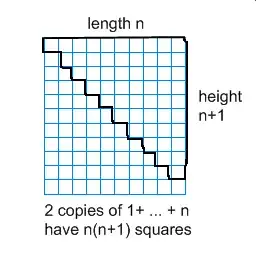We know that Gauss has shown that the sum $S$ of the first $n$ natural numbers is given by the relation:
$$S=\frac{n(n+1)}{2} \tag{*}$$ The proof that I remember most frequently is as follows:
Let be $S=1+2+\dotsb+(n-1)+n \tag{1}$ We can write $S$ it also as: $\tag{2} S=n+(n-1)+\dotsb+2+1.$ By adding up member to member we get: $\tag{3} 2S=\underbrace{(n+1)+(n+1)+\dotsb+2+1}_{n-\mathrm{times}}.$ Hence we obtain the $(^\ast)$.
How many other simple methods exist to calculate the sum of the first natural numbers?
